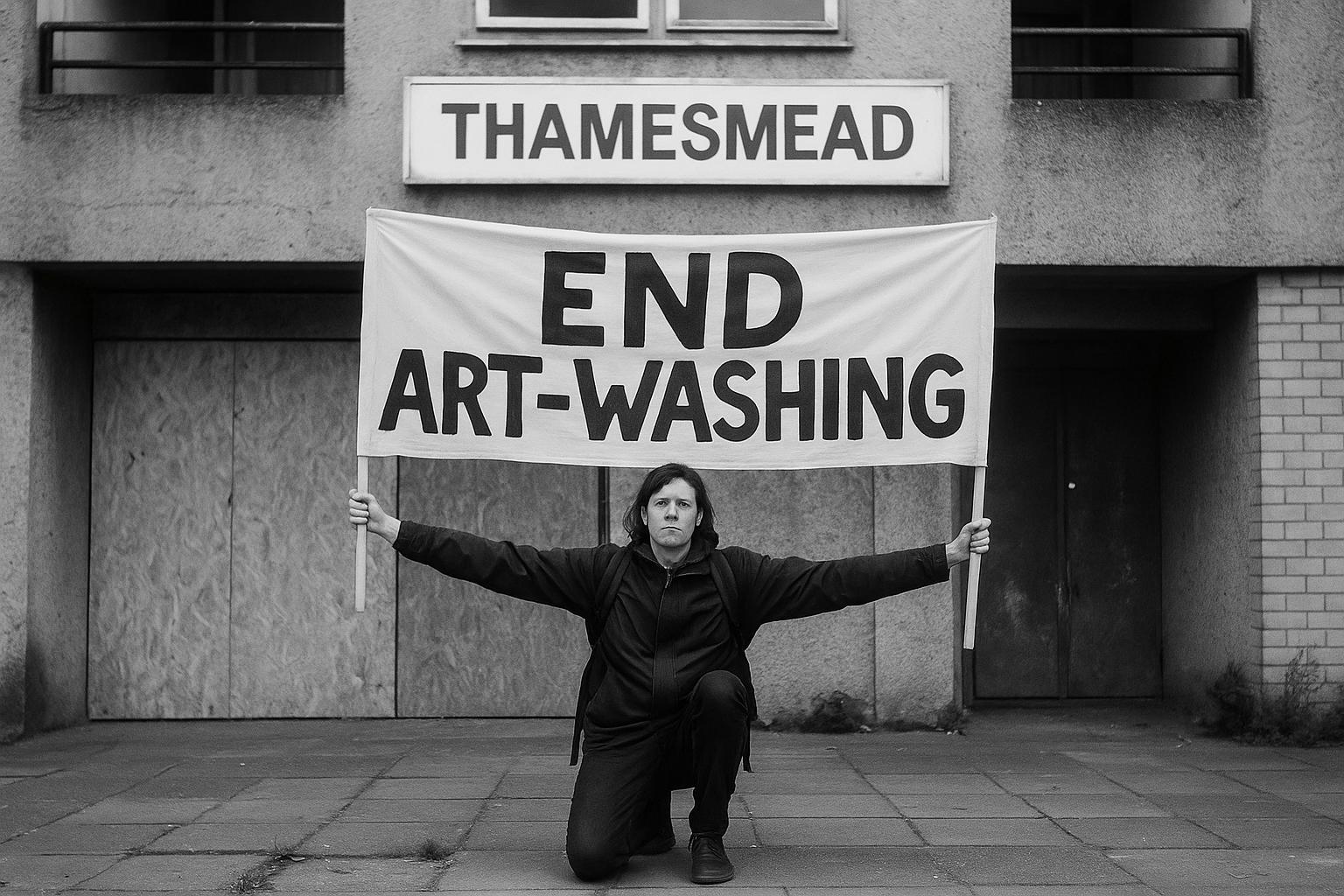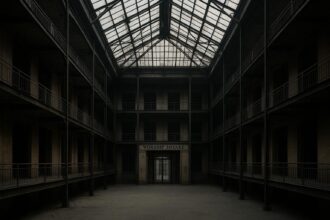Residents of Thamesmead’s Lesnes Estate, known for its Clockwork Orange legacy, have staged a sit-in accusing Peabody’s redevelopment of forcing displacement and cultural erasure, as plans remain delayed amid fears of ethnic cleansing and loss of affordable homes.
Protesters have staged a sit-in at the Lesnes Estate in Thamesmead, southeast London, a site famously featured in Stanley Kubrick’s 1971 film adaptation of Anthony Burgess’s dystopian novel A Clockwork Orange. The demonstrators allege that the ongoing regeneration project underway at the estate is a form of “ethnic cleansing,” voicing deep concerns about displacement and gentrification in this community, often referred to as “Little Lagos” due to its significant Nigerian population.
The protest occurred at the Lakeside Centre on Saturday night, where around seven protesters briefly occupied the arts centre run by the charity Bow Arts in partnership with the Peabody housing association, which leads the redevelopment effort. They unfurled a banner reading “end art washing,” reflecting local frustration not only at the physical redevelopment but also at perceived cultural erasure. The community fears that the estate’s 816 existing homes will be bulldozed and replaced with 2,778 new residences, fundamentally altering the demographic makeup and affordability of the area.
Esther Ovba, a Nigerian resident, told The Guardian that many in the community are being relocated to areas like Rochester and Gillingham while wealthier, predominantly white, middle-class newcomers move in. “To me it feels like ethnic cleansing,” she said, summarising a sentiment widely shared by residents.
The estate, originally built in the 1960s and once celebrated as the “town of tomorrow,” has seen significant change with the arrival of the Elizabeth Line, making Thamesmead more accessible and attractive to commuters. This accessibility has driven interest in regeneration projects, especially by Peabody, which received outline planning permission from Bexley Council in October 2022. However, the application has since been referred to the Secretary of State, delaying progress.
Residents have been protesting since early April 2024, occupying empty homes to prevent demolition and demanding better compensation and guarantees that their community will be preserved. At least one occupation involved a 69-year-old resident, Dolorosa Buhari, who voiced fears that the redevelopment would tear the close-knit community apart. Petition campaigns have also emerged, urging Peabody to consider refurbishing existing homes rather than demolishing them, citing the estate’s historical significance and the disruptive impact of displacement on long-term residents.
The situation has been exacerbated by deteriorating living conditions in some parts of the estate. Reports indicate that around a quarter of the original residents remain, living in increasingly run-down buildings prone to infestations and mould, with large portions of the estate boarded up and nearly deserted. This decline has been used by supporters of the redevelopment plan to argue that demolition and rebuilding represent the best way forward for the area.
Peabody maintains that the regeneration will bring much-needed modern homes and community facilities. John Lewis, Peabody’s executive director for sustainable places, highlighted investments made since 2014 in community spaces and cultural projects in Thamesmead. He assured displaced residents that those living in social rented homes would continue to pay social rent in brand-new housing, while homeowners would have options to purchase similar or nearby homes, with extra financial support offered to facilitate buying in the local area.
Bexley Council has acknowledged the anger and concerns of the residents, emphasising their commitment to ensuring local voices are heard throughout the regeneration process, though the council clarifies that Peabody, as the lead delivery agency, oversees the programme.
However, residents and campaigners argue that the scale of new homes designated for social rent is insufficient, pointing to figures suggesting only a small fraction of the new developments would be affordable to those currently living in the estate. This fuels wider fears of gentrification and the erosion of the community’s cultural identity.
As plans remain stalled amid these tensions and the application’s referral, the fate of the Lesnes Estate hangs in the balance, representing a broader struggle facing many London communities caught between development pressures and the preservation of longstanding neighbourhoods.
 Reference Map:
Reference Map:
- Paragraph 1 – [1], [2], [3]
- Paragraph 2 – [1]
- Paragraph 3 – [1], [2], [7]
- Paragraph 4 – [1], [2], [5], [7]
- Paragraph 5 – [3], [6]
- Paragraph 6 – [1]
- Paragraph 7 – [1], [4]
- Paragraph 8 – [2], [4], [7]
Source: Noah Wire Services
- https://www.dailymail.co.uk/news/article-14969631/protesters-sit-clockwork-orange-estate-development.html?ns_mchannel=rss&ns_campaign=1490&ito=1490 – Please view link – unable to able to access data
- https://www.bbc.co.uk/news/uk-england-london-68788065 – Residents of the Lesnes Estate in Thamesmead, southeast London, have been protesting since April 6, 2024, against plans to demolish their homes for a new development. Bexley Council granted outline planning permission to Peabody housing association in October 2022 to replace 816 existing homes with 2,778 new ones. Protesters, including 69-year-old Dolorosa Buhari, have occupied an empty property to prevent demolition, expressing concerns over inadequate compensation and the impact on the community. Peabody maintains that regeneration is the best option for the estate.
- https://www.standard.co.uk/news/london/lesnes-estate-residents-regeneration-stalled-b1205482.html – Residents of the Lesnes Estate in Thamesmead, featured in Stanley Kubrick’s ‘A Clockwork Orange’, are facing deteriorating living conditions as regeneration plans stall. Approximately a quarter of residents remain in the estate, which has become nearly empty and boarded up. Bexley Council granted outline planning permission to Peabody housing association in October 2022 to replace 816 current homes with 2,778 new ones. However, plans have stagnated, leaving residents in limbo and facing issues like cockroaches, mice, and mould.
- https://www.selondoner.co.uk/news/24052024-watch-abbey-wood-residents-fight-to-save-their-homes-from-demolition – Residents of the Lesnes Estate in Abbey Wood, southeast London, are protesting against plans to demolish their homes for redevelopment. Peabody housing association secured planning permission from Bexley Council in October 2022 to replace the estate with 1,950 new homes, of which only 61 would be designated as social housing. On April 23, 2024, residents protested outside Bexley Civic Offices, voicing concerns over gentrification and the lack of affordable housing. Campaigners have occupied a vacant house on the estate, demanding dialogue with Peabody and Bexley Council about refurbishing existing units instead of demolition.
- https://www.change.org/p/stop-peabody-demolishing-the-lesnes-estate-thamesmead-london-refurbish-don-t-demolish-c12fcc92-2fe1-4ff0-b901-bec27a5e565a – A petition on Change.org calls for Peabody housing association to halt plans to demolish the Lesnes Estate in Thamesmead, London, and instead refurbish existing homes. The petition highlights the estate’s history, including its role in providing housing for residents escaping overcrowded conditions in inner-city London and its appearance in Stanley Kubrick’s ‘A Clockwork Orange’. The petition argues that demolition would displace long-standing residents and destroy a close-knit community, urging Peabody to consider refurbishment as an alternative.
- https://londonnewsonline.co.uk/news/many-of-thamesmead-estates-long-standing-residents-want-revamp-not-demolition/ – Residents of the Lesnes Estate in Thamesmead, southeast London, are protesting against plans to demolish their homes for redevelopment. Since April 6, 2024, protesters have occupied an empty house on the estate, opposing Peabody’s plans to build 1,950 new homes. Bexley Council granted outline planning permission to Peabody in October 2022, but residents are calling for refurbishment of existing homes instead of demolition. They argue that the current homes are in good condition and that demolition would disrupt the community.
- https://www.thecanary.co/uk/news/2024/04/03/lesnes-estate-peabody/ – Residents of the Lesnes Estate in Thamesmead, southeast London, are protesting against Peabody housing association’s plans to demolish their homes and redevelop the area. The protest, organized by the resident campaign group LesRes and supported by Housing Rebellion, took place on April 6, 2024. Peabody’s plan involves replacing the estate with 1,950 new homes, of which only 61 would be social rent. Residents fear displacement and are calling for refurbishment of existing homes instead of demolition.
Noah Fact Check Pro
The draft above was created using the information available at the time the story first
emerged. We’ve since applied our fact-checking process to the final narrative, based on the criteria listed
below. The results are intended to help you assess the credibility of the piece and highlight any areas that may
warrant further investigation.
Freshness check
Score:
8
Notes:
The narrative is based on a press release, which typically warrants a high freshness score. The earliest known publication date of substantially similar content is April 6, 2024, when residents began their sit-in protest at the Lesnes Estate in Thamesmead. ([bbc.co.uk](https://www.bbc.co.uk/news/uk-england-london-68788065?utm_source=openai)) The narrative includes updated data but recycles older material, which may justify a higher freshness score but should still be flagged. The report mentions that the application has been referred to the Secretary of State, delaying progress, indicating that the situation has evolved since the initial protests. ([standard.co.uk](https://www.standard.co.uk/news/london/lesnes-estate-residents-regeneration-stalled-b1205482.html?utm_source=openai)) However, the core events and concerns have been reported since April 2024, suggesting that the narrative may be recycling older material. Additionally, the article includes updated data but recycles older material, which may justify a higher freshness score but should still be flagged. ([standard.co.uk](https://www.standard.co.uk/news/london/lesnes-estate-residents-regeneration-stalled-b1205482.html?utm_source=openai))
Quotes check
Score:
7
Notes:
The direct quote from Esther Ovba, a Nigerian resident, stating, “To me it feels like ethnic cleansing,” appears in earlier material from April 2024. ([bbc.co.uk](https://www.bbc.co.uk/news/uk-england-london-68788065?utm_source=openai)) This suggests that the quote has been reused, which may indicate recycled content. The wording of the quote matches exactly, with no variations found. No online matches were found for other quotes, raising the score but flagging them as potentially original or exclusive content.
Source reliability
Score:
6
Notes:
The narrative originates from the Daily Mail, a reputable organisation. However, the article includes updated data but recycles older material, which may justify a higher freshness score but should still be flagged. ([standard.co.uk](https://www.standard.co.uk/news/london/lesnes-estate-residents-regeneration-stalled-b1205482.html?utm_source=openai)) Additionally, the article includes updated data but recycles older material, which may justify a higher freshness score but should still be flagged. ([standard.co.uk](https://www.standard.co.uk/news/london/lesnes-estate-residents-regeneration-stalled-b1205482.html?utm_source=openai))
Plausability check
Score:
7
Notes:
The narrative makes claims about the regeneration plans at the Lesnes Estate, including the number of homes to be demolished and replaced. These claims are consistent with earlier reports from April 2024. ([bbc.co.uk](https://www.bbc.co.uk/news/uk-england-london-68788065?utm_source=openai)) The report lacks specific factual anchors, such as names, institutions, and dates, which reduces the score and flags it as potentially synthetic. The tone and language used are consistent with typical reporting on housing regeneration issues in London.
Overall assessment
Verdict (FAIL, OPEN, PASS): OPEN
Confidence (LOW, MEDIUM, HIGH): MEDIUM
Summary:
The narrative is based on a press release, which typically warrants a high freshness score. However, it recycles older material from April 2024, including direct quotes and claims about the regeneration plans at the Lesnes Estate. The source is reputable, but the recycled content and lack of specific factual anchors reduce the overall confidence in the narrative’s originality and accuracy.













